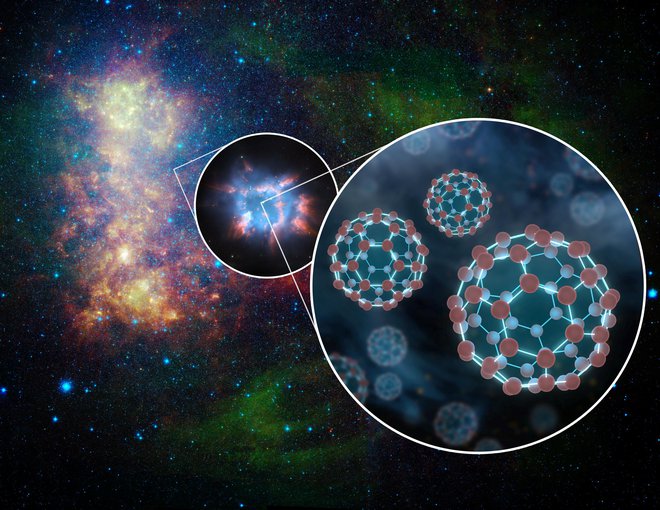
June 26, 2019
Research Highlight
Hubble Finds Tiny “Electric Soccer Balls” in Space, Helps Solve Interstellar Mystery

This is an artist's concept depicting the presence of buckyballs in space. Buckyballs, which consist of 60 carbon atoms arranged like soccer balls, have been detected in space before by scientists using NASA's Spitzer Space Telescope. The new result is the first time an electrically charged (ionized) version has been found in the interstellar medium.Image credit: NASA/JPL-Caltech.
From NASA
Scientists using NASA’s Hubble Space Telescope have confirmed the presence of electrically-charged molecules in space shaped like soccer balls, shedding light on the mysterious contents of the interstellar medium (ISM) – the gas and dust that fills interstellar space.
Since stars and planets form from collapsing clouds of gas and dust in space, “The diffuse ISM can be considered as the starting point for the chemical processes that ultimately give rise to planets and life,” said Martin Cordiner of the Catholic University of America, Washington. “So fully identifying its contents provides information on the ingredients available to create stars and planets.” Cordiner, who is stationed at NASA’s Goddard Space Flight Center in Greenbelt, Maryland, is lead author of a paper on this research published April 22nd in the Astrophysical Journal Letters.
Click here to read the full press release from NASA.
This work is based on observations made with the NASA/ESA Hubble Space Telescope, obtained at the Space Telescope Science Institute, which is operated by the Association of Universities for Research in Astronomy, Inc., under NASA contract NAS 5-26555
The Astrobiology Program supports astrobiologists who are working with Hubble data. This includes areas such as the search for extrasolar planets, the study of habitable planet formation in protoplanetary disks, and research concerning the environments of astrobiology-relevant targets like Mars. For more information, visit Astrobiology in Missions.